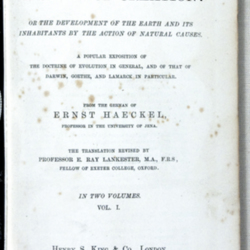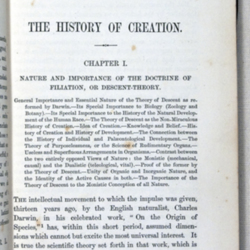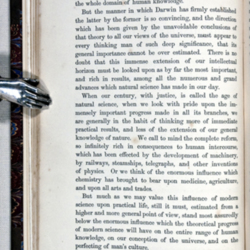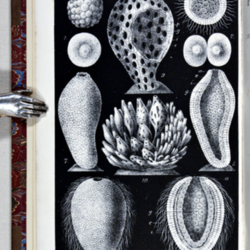Ernst Haeckel. The History of Creation, 1876.
Ernst Haeckel.The History of Creation: Or the Development of the Earth and Its Inhabitants by the Action of Natural Causes. Revised translation by Prof. E. Ray Lancaster. 2 vols. London: King, 1876.
A key piece of evidence in Haeckel's support for Darwin's evolutionary theory, "this immense extension of our human horizon" (History of Creation, I: 2), were the "Kalkschwämme" or calcareous sponges. Haeckel spent several years collecting, drawing, and describing these organisms. He had studied morphology with, among others, Agassiz's former college classmate and brother-in-law, the eminent botanist Alexander Braun. His work with sponges convinced Haeckel that all multicellular organisms, "through numberless gradational transitional forms," were derived phylogenetically from a universal archetype or ancestor, an origin that is still reflected in the embryo stage of all living creatures. This insight provided the basis for Haeckel's famous dictum: "Ontogeny recapitulates phylogeny."
The history of creation : or, The development of the earth and its inhabitants by the action of natural causes. A popular exposition of the doctrine of evolution in general, and of that of Darwin, Goethe and Lamarck in paticular / from the German of Ernst Haeckel the translation revised by Professor E. Ray Lankester.
The history of creation : or, The development of the earth and its inhabitants by the action of natural causes. A popular exposition of the doctrine of evolution in general, and of that of Darwin, Goethe and Lamarck in paticular / from the German of Ernst Haeckel the translation revised by Professor E. Ray Lankester.
The history of creation : or, The development of the earth and its inhabitants by the action of natural causes. A popular exposition of the doctrine of evolution in general, and of that of Darwin, Goethe and Lamarck in paticular / from the German of Ernst Haeckel the translation revised by Professor E. Ray Lankester.
The history of creation : or, The development of the earth and its inhabitants by the action of natural causes. A popular exposition of the doctrine of evolution in general, and of that of Darwin, Goethe and Lamarck in paticular / from the German of Ernst Haeckel the translation revised by Professor E. Ray Lankester.
Haeckel believed he had identified one such ancestral form of the calcareous sponge, the "Olynthus," derived in turn from an even simpler form, the "gastrula," which Haeckel came to view as the "Ur-form" of all living beings. The hauntingly beautiful frontispiece to the English translation of Haeckel's History of Creation depicts, in Haeckel's characteristic style, the development of a sponge. It is easy to see why Haeckel's elegant designs have reminded more than one viewer of art nouveau. Figure 10 in the frontispiece is particularly memorable: it vividly demonstrates how several forms may grow out of a single stock or "cormus," a phenomenon Haeckel called "metrocormy." As Haeckel saw it, "this solid and tangible piece of evidence in favour of the common descent of different species ought, one would think, to satisfy the most determined sceptic!" (History of Creation I: xiii). For more on Haeckel's images, see Stephen Jay Gould, The Hedgehog, the Fox, and the Magister's Pox (New York: Three Rivers, 2003) 155-63.








